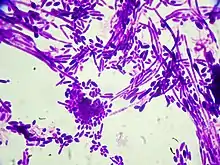Candida dubliniensis
Candida dubliniensis is a fungal opportunistic pathogen originally isolated from AIDS patients. It is also occasionally isolated from immunocompetent individuals. It is of the genus Candida, very closely related to Candida albicans but forming a distinct phylogenetic cluster in DNA fingerprinting. It is most commonly isolated from oral cavities,[1] and is also occasionally found in other anatomical sites.
| Candida dubliniensis | |
|---|---|
 | |
| Gram stain of Candida dubliniensis cells (1000-fold magnification) | |
| Scientific classification | |
| Domain: | Eukaryota |
| Kingdom: | Fungi |
| Division: | Ascomycota |
| Class: | Saccharomycetes |
| Order: | Saccharomycetales |
| Family: | Saccharomycetaceae |
| Genus: | Candida |
| Species: | C. dubliniensis |
| Binomial name | |
| Candida dubliniensis Sullivan et al. (1995) | |
Prevalence and epidemiology
Candida dubliniensis is cosmopolitan (found around the world), and has been described as a separate species in 1995.[2] Retrospective studies have shown that previously it had been commonly identified as Candida albicans, with which C. dubliniensis is closely related and shares a number of characteristics.
One test for distinguishing C. dubliniensis from C. albicans, is laboratory culture of the organism at 42 °C. Most C. albicans strains grow at this temperature,[3] whereas most C. dubliniensis isolates do not.[2] There are also significant differences in the conditions that lead to the formation of chlamydospores between C. albicans and C. dubliniensis, although they are otherwise phenotypically very similar.[2]
The Memorial Sloan-Kettering Cancer Center conducted several studies, both retrospective and prospective. In 974 germ-tube positive yeasts, 22 isolates (2.3%) from 16 patients were C. dubliniensis. All individuals were immunologically compromised with either malignancy or AIDS, and the isolates came from a variety of different sites. C. dubliniensis was also isolated from the mouths of 18% of patients with diabetes and who use insulin.[4]
Antifungal susceptibility
In one study, all 20 C. dubliniensis isolates tested were susceptible to itraconazole, ketoconazole and amphotericin B.[5]
Fluconazole
Many isolates of C. dubliniensis are sensitive to fluconazole. In one study, sixteen of twenty isolates were sensitive to fluconazole, while four were resistant.[5] It has been hypothesized that C. dubliniensis possesses the ability to rapidly develop resistance to fluconazole, especially in patients on long-term therapy.[5]
References
- Gilfillan, G. D.; Sullivan, D. J.; Haynes, K.; Parkinson, T.; Coleman, D. C.; Gow, N. A. R (1998). "Candida dubliniensis: phylogeny and putative virulence factors". Microbiology. 144 (4): 829–838. doi:10.1099/00221287-144-4-829. PMID 9579058.
- Sullivan DJ, Westerneng TJ, Haynes KA, Bennett DE, Coleman DC (1995). "Candida dubliniensis sp. nov.: phenotypic and molecular characterization of a novel species associated with oral candidosis in HIV-infected individuals". Microbiology. 141 (7): 1507–21. doi:10.1099/13500872-141-7-1507. PMID 7551019.
- Kamiyama A; Niimi M; Tokunaga M; . Nakayama H (1989). "Adansonian study of Candida albicans: intraspecific homogeneity excepting C. stellatoidea strains". J Med Vet Mycol. 27 (4): 229–241. doi:10.1080/02681218980000311. PMID 2677300.
- Willis AM, Coulter WA, Sullivan DJ, Coleman DC, Hayes JR, Bell PM, Lamey PJ (2000). "Isolation of C. dubliniensis from insulin-using diabetes mellitus patients". J Oral Pathol Med. 29 (2): 86–90. doi:10.1034/j.1600-0714.2000.290206.x. PMID 10718404.
- Moran GP, Sullivan DJ, Henman MC, McCreary CE, Harrington BJ, Shanley DB, Coleman DC (March 1997). "Antifungal drug susceptibilities of oral Candida dubliniensis isolates from human immunodeficiency virus (HIV)-infected and non-HIV-infected subjects and generation of stable fluconazole-resistant derivatives in vitro". Antimicrob. Agents Chemother. 41 (3): 617–23. doi:10.1128/AAC.41.3.617. PMC 163761. PMID 9056003.